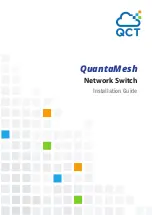
Chapter 13
| Basic Administration Protocols
Simple Network Management Protocol
– 373 –
the possibility that the Notification message is lost, and applications can poll
the log to verify that they have not missed any important Notifications.
◆
If notification logging is not configured, when the switch reboots, some SNMP
traps (such as warm start) cannot be logged.
◆
To avoid this problem, notification logging should be configured as described
in this section, and these commands stored in the startup configuration file
using the System > File (Copy – Running-Config) page as described on
Then when the switch reboots, SNMP traps (such as warm start) can now be
logged.
◆
Based on the default settings used in RFC 3014, a notification log can contain
up to 256 entries, and the entry aging time is 1440 minutes. Information
recorded in a notification log, and the entry aging time can only be configured
using SNMP from a network management station.
◆
When a trap host is created using the Administration > SNMP (Configure Trap –
Add) page described on
, a default notify filter will be created.
Parameters
These parameters are displayed:
◆
IP Address
– The IPv4 or IPv6 address of a remote device. The specified target
host must already have been configured using the Administration > SNMP
(Configure Trap – Add) page.
The notification log is stored locally. It is not sent to a remote device. This
remote host parameter is only required to complete mandatory fields in the
SNMP Notification MIB.
◆
Filter Profile Name
– Notification log profile name. (Range: 1-32 characters)
Web Interface
To create an SNMP notification log:
1.
Click Administration, SNMP.
2.
Select Configure Notify Filter from the Step list.
3.
Select Add from the Action list.
4.
Fill in the IP address of a configured trap manager and the filter profile name.
5.
Click Apply
Summary of Contents for GEL-1061
Page 14: ...Contents 14...
Page 28: ...Section I Getting Started 28...
Page 38: ...Chapter 1 Introduction System Defaults 38...
Page 40: ...Section II Web Configuration 40...
Page 60: ...Chapter 2 Using the Web Interface Navigating the Web Browser Interface 60...
Page 164: ...Chapter 6 Address Table Settings Issuing MAC Address Traps 164...
Page 192: ...Chapter 8 Congestion Control Storm Control 192...
Page 204: ...Chapter 9 Class of Service Layer 3 4 Priority Settings 204...
Page 216: ...Chapter 10 Quality of Service Attaching a Policy Map to a Port 216...
Page 430: ...Chapter 14 Multicast Filtering MLD Snooping Snooping and Query for IPv4 430...
Page 436: ...Chapter 15 IP Tools Address Resolution Protocol 436...
Page 474: ...Section III Appendices 474...
Page 492: ...Glossary 492...
Page 500: ...E052016 ST R02 150200001416A...
















































